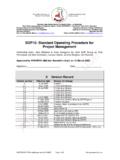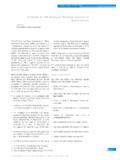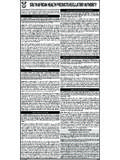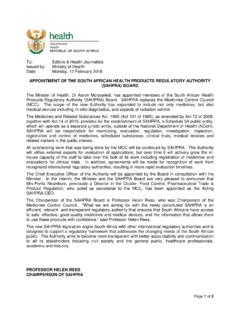Transcription of Management of the Patient With Congestive Heart Failure ...
1 Management of the Patient With CongestiveHeart Failure Using Outpatient, Home, andPalliative CareSusan E. Quaglietti, J. Edwin Atwood, Laurie Ackerman, and Victor FroelicherCongestive Heart Failure is a chronic, debilitatingillness, with increasing prevalence in the elderly. Itis one of the most common causes for hospitaladmission, and associated treatment costs are es-timated at $ billion. Despite improved survivalwith medical therapy, beneficial effects on qualityof life have not been consistently reported. In ad-dition, optimum medical therapy, as recommendedby evidence-based guidelines, are not always im-plemented.
2 Counseling and education involving di-etary modifications,activity recommendations,medication Management , self-monitoring, progno-sis, coping skills, social support, caregiver stress,and spiritual needs are critical components in themanagement of Heart Failure through initial diagno-sis to end of life. Within the last decade, closefollow-up for Congestive Heart Failure has been as-sociated with decreased hospitalizations, reducedhospital length of stay, improved functional status,better compliance, lower costs, and improved sur-vival.
3 Research trials have mainly been observa-tional and small, and they have used different in-terventions. Little has been written regarding out- Patient Management of the Patient with advancedcongestive Heart Failure , and none of the currentpublished guidelines addresses recommendationsfor the New York Heart Association class IV (otherthan for transplant candidacy). New models ofclose follow-up for chronic and advanced conges-tive Heart Failure should be investigated. Thesemodels could be implemented in urban and ruralsettings and be supported by private insurance D 2000 by Saunders Companycongesttve Heart Failure (CHF) is a majorchrome tllness m the United States, wtth anenormous impact on health care costs.
4 It is esti-mated that more than 4 million persons m theUnited States have CHF, and it is present m ahnost10% of persons older than 70 years. It is the onlycardiovascular disease that is increasmg in inct-dence and ,L Heart Failure is the mostcommon diagnosis in hospitalized patients olderthan 65 years. One third of the patients hospital-ized for CHF are readmitted within 90 days ofdischarge. Prognosis with CHF is poor, with 1 in5 patients dying within 1 year of diagnosis andhalf within 5 Survival estimates are worsefor men than women.
5 Fewer than 20% of patients,regardless of age or gender, survive longer than 10years, and CHF prognosis is worse m elderly sub-jects of both Annual direct health careexpendttures for CHF in the United States havebeen estimated at $20 to $40 bilhon, with $8 to$15 billion spent on hospitalization disorders of the pericardium, myocar-dium, and endocardium can lead to Heart Failure ,but 80% of CHF is due to left ventricular systolicdysfunction. Coronary artery disease (CAD) is theleading cause of Heart Failure , occurring in ap-proximately two thuds of patients with CHF can be caused by hypertension(HTN), alcohol abuse, thyrotd disease, myocardi- tis, and idiopathic reasons (idiopathic-dilated car-diomyopathy).
6 Treatment options include non-pharmacologic measures, medication therapy,and assessment for surgtcal ~8 Useof angiotension-convertmg enzyme (ACE) inhib-From the Departments of Cardiology and Home-BasedPrtmary Care, Palo Alto Veterans Affairs, Palo Alto, reprint requests to Susan Quaglietti, RN, MSN,ANP, Cardiology Dwision (lllc), VA Palo Alto HealthCare System, 3801 Miranda Ave, Palo Alto, CA o 2000 by Saunders Company0033-0620/00/4303-0005$1 in Cardiovascular Diseases, Vol 43, No 3 (November/December), 2000, pp 259-274259260 QUAGLIE77 l ET ALity by pedometer score were a srronger predictorofdeath (P < ,001) than laboratory-based exercisetests.
7 The Study to understand Prognoses andPreferences for Outcomes and Risks of Treat-ments (SUPPORT) investigators 3 found that snr-viva1 among 1,390 adult patients with CHF, withmedian age of 68 years, was only at 1 with other reported studies, a high percentageof comorbid conditions were present:-4556 withmyocardial infarction, 33% with diabetes, and20% with COPD. At 6 months, 40 6 of patientswere dependent in 1 or more activity of daily liv-ing (ADL), even though 59% of patients reportedQOL between good and rates for CHF doubled between1973 and 1986, + with the steepest increaseamong those older than 74 years.
8 Croft et alI5reviewed Medicare hospital claims of 631,306 pa-tients from 1986 and 803,506 patients from 1993who had initial hospitalizations for CHF. Age-standardized hospitalization rares for any diagno-sis of CHF was higher during 1993, discharge tohome health services doubled (6% to 12%), andmore than 25% of all admissions, regardless ofrace or sex, were in patients 85 years or older. Asexpected, the most frequently reported secondmydiagnoses were ischemic Heart disease, COPD,HTN, and diabetes.
9 Hospitalization rates mayeven be higher, depending on which reportingmeasures are used. Goff et all6 reported that reli-ance on International Classification of Disease(ninth revision) codes during hospitalization re-sulted in missing one third of the patients withclinical evidence of acute rates 6 months postdischarge forCHF are as high as 4496, with exacerbation ofCHF accounting for 18%. There are multiple pre-cipitating factors that contribute to this exacerba-tion. More than 65% of patients admitted for heartfailure exacerbation were due to lack of compli-ance with either drugs.
10 Dietary indiscretions, Other factors contributing to readmissionof older Heart Failure patients include age, gender,premature discharge, failing or nonexistent sup-port system, and polypharmacy. In addition to progressive, poor functional sta-tns and increasing hospitalization trends, outpa-tient medical Management of the Patient withCHF does nor consistently follow practice guide-lines. To improve survival. maintain and improveclinicalstatus, and prevent readmission ofpatientsitors has improved survival and is now standardtherapy unless contraindicated.






